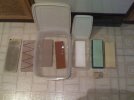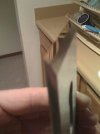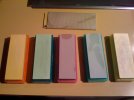Hi,
Im thinking of upgraing my waterstones.
I have a 1000/6000 stone that by looks and descriptions might be the king stone.
I also have a rough cheap stone to create bevels, this stone is going to die soon.
1) I am thinking of purchasing either the cerax 320 or chosera 400 to replace the rough one
2) as a finisher i decided to add the naniwa super stone 12000 as it has good reputation.
3) the king(?) 6000 side seems not to be able to remove scratches of its 1000 side on harder blades (like my razor) on softer blades it works but takes a while, it is a fairly big jump too. Also it loads up quickly.
So here are my questions:
- What would be the best single stone to close the gap between the 1k and 12k effectively? i would like to have a perfect mirror with as little steps/time/money as possible.
- if not a single stone, what progression would you choose? Should i leave the 6000 king out and replace it or just add something in between
There is a chance that i will replace the 1000 gritt with something later as well (maybe chosera 800)
Here is a list of stones that i have my eye on due to their feel and feedback.
chosera 3000
suehiro rika 5000
kitayama 8000
Feel free to suggest more.
Right now after the 6k i finísh with various stropping pastes. It works but takes too long.
Im thinking of upgraing my waterstones.
I have a 1000/6000 stone that by looks and descriptions might be the king stone.
I also have a rough cheap stone to create bevels, this stone is going to die soon.
1) I am thinking of purchasing either the cerax 320 or chosera 400 to replace the rough one
2) as a finisher i decided to add the naniwa super stone 12000 as it has good reputation.
3) the king(?) 6000 side seems not to be able to remove scratches of its 1000 side on harder blades (like my razor) on softer blades it works but takes a while, it is a fairly big jump too. Also it loads up quickly.
So here are my questions:
- What would be the best single stone to close the gap between the 1k and 12k effectively? i would like to have a perfect mirror with as little steps/time/money as possible.
- if not a single stone, what progression would you choose? Should i leave the 6000 king out and replace it or just add something in between
There is a chance that i will replace the 1000 gritt with something later as well (maybe chosera 800)
Here is a list of stones that i have my eye on due to their feel and feedback.
chosera 3000
suehiro rika 5000
kitayama 8000
Feel free to suggest more.
Right now after the 6k i finísh with various stropping pastes. It works but takes too long.



